



The 4th Radiator festival. Going Underground – Surveillance and Sousveillance.
“The more perfect civilisation is, the less occasion has it for government, because the more does it regulate its own affairs, and govern itself…”
The Rights of Man by Thomas Paine.
Many readers will remember their fave sci-fi, fantasy and social-political movies, exploring and relating to themes of humanity’s civil liberties threatened by technological means. One movie which springs to mind is Enemy of the State, starring Will Smith as Robert Clayton Dean, released in 1998. The film was about a group of rogue NSA agents who kill a Congressman in a political-related murder, and then try to cover up the murder by destroying evidence and intimidating witnesses. It explored and exploited our worries, fantasies and paranoias around technology being used against us by those who have power within the realms of government agencies. In contrast to such adventurous and playful films with their stylish visions and high-octane, scenarios; we are presently faced with something less imaginative and sadly, more predictable. In the real world, as in ‘real’ digital networks and everyday human environments, the creep of surveillance has entered everyday life.
We have emerged into a complex world, inter-meshed in digital and virtual technologies, harbouring social networks and on-line communities, alongside the ever expansive growth of mobile and portable platforms; facilitating us to share with others our moments of immediacy. The convenience of connecting with others has opened a multitude of doors to a complicated era. We have become part of a larger world which is also shrinking at the same time. We are globalized citizens, united not only through economic work-related directives, but data. Behaviour related products for markets thrive on trying to find out what we are doing and thinking. We are a rich resource, fresh territories for knowledge. Digital data about us, ‘civilians’ is big business. Many individuals and organisations including artists, are cashing in on the rush to make money out of our digital identities and behaviours. Whether it be in the supermarket, with I.D cards, on the Internet or by tracing people’s movements on the streets.
The Radiator Festival and Symposium was curated and organised by Anette Schafer and Miles Chalcraft, co-founders and continual main instigators of Trampoline with support from Matt Davenport. Trampoline has hosted and curated events in both Nottingham and Berlin since 1997. Exploits in the Wireless City is the 4th Radiator festival and symposium to date, which lasted from 13th to 24th January 2009, 10 days of Exhibitions, Events, Screenings, Music, Artists’ Talks and more. This time the main theme was about engaging in an active shared dialogue, around the development of digital networks transforming and effecting people’s everyday lives, whether it be public or private space. “In its critique, Radiator will question the opportunities, future strategies and implementations that artists and communities face when learning to act within these new hybrid city spaces.”
My visit was on a different day from the symposium and even though I usually enjoy a good hearty debate, it felt important not to dilute my experience. Nottingham was given a quality treat outside of its usual, consumer orientated vices in witnessing and being part of this festival. The art was accessible from different venues around the city, the Surface Gallery, Hand and Heart gallery, Broadway Media Centre and also the QUAD in Derby.
For the festival a commission was set up, called Going Underground, inviting artists to submit work about surveillance and Sousveillance. The artists selected, were Glenn Davidson (exponentially), N55 Intelligence Agency (NIA), Folke Kobberling & Martin Kaltwasser, The Office of Community Sousveillance, Christian Nold, as well as the guest artists Stanza, Sebastian Craig and Candice Jacobs.
Before we move straight into exploring some of the work featured as part of the Going Underground commission. I need to lay out some context…
In 2006 a research document called A Report on the Surveillance Society For the Information Commissioner was published. Produced by a group of academics called the Surveillance Studies Network. The report was presented to the 28th International Data Protection and Privacy Commissioners’ Conference in London, hosted by the Information Commissioner’s Office. The publication begins by saying “Conventionally, to speak of surveillance society is to invoke something sinister, smacking of dictators and totalitarianism. We will come to Big Brother in a moment but the surveillance society is better thought of as the outcome of modern organizational practices, businesses, government and the military than as a covert conspiracy. Surveillance may be viewed as progress towards efficient administration, in Max Weber’s view, a benefit for the development of Western capitalism and the modern nation-state.”[1]
To deny that Surveillance is systematically effecting a modern day panopticon[2] for UK citizens, more highlights where their priorities lie. One priority seems to be an unquestioning protocol in support of the needs of a market system over the needs of civilian rights. Such a stance communicates a behaviour which is complicit in promoting a hegemony that lacks compassion or empathy of the very real circumstances of public freedoms being eroded for the sake of corporate economics rather than nurturing human, social contexts. Make no mistake, this is the privatisation of our public spaces, civil liberties are pushed aside as a secondary factor, rather too easily at whatever price.
So, if we cannot rely on our governments and local councils to do the honourable thing and take responsibility in effectively challenging this encroachment on our civil liberties, who can we turn to? Thankfully, there has been much debate around the subject in the media the last few years. Whether the government is able to step outside of its current mind-set, and become less blinkered is another thing. So, there needs to be as many different forms of communication around the issue so others from all walks of life can be included to share a critique from their own perspectives. In this context, regarding the festival we have artists who also happen to be experimenting with activism as part of their dialogue, initiating imaginative forms of expression to enable and facilitate varied processes in, getting their critical thoughts on subjects which matter, out there. “…artists using CCTV are critical of the present level of surveillance, but they’re also interested in establishing a dialogue about what is typically a secretive arrangement”[3]
The Surface Gallery successfully presented a dynamic and varied collection of art on the subject. Stanza’s ‘Stars of CCTV’, hung on the wall were representations of the ‘Big Brother’ generation, re-mediated as history paintings representing a social portrait of England. Displayed in expensive white frames, these works showed ghostly, chilling blurred images “each picture has a narrative, a history of time and place”.
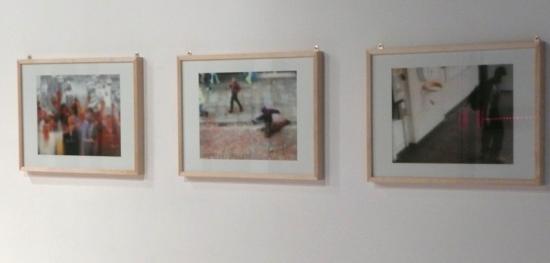 Stanza. Stars of CCTV.
Stanza. Stars of CCTV.
The images depict the last whereabouts of a lawyer, the July bombers, happy slappers beating someone up, people drunk in the street, thefts at gunpoint, sex in car, running someone over, stealing from a shop and trying the stuff on first. Other images include police abuse, child abduction, senseless fighting and terrorists using public transport.”
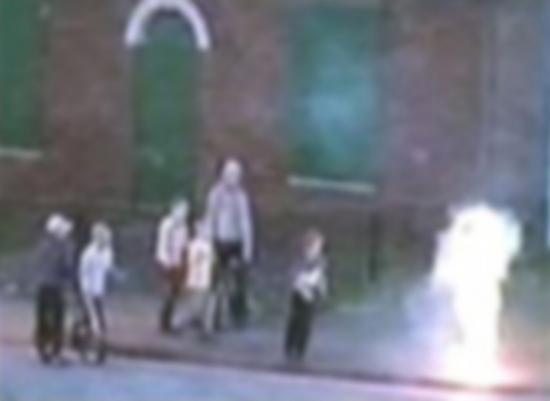 Stanza. We Dont Want No Education.
Stanza. We Dont Want No Education.
Anonymous faces stare back at the CCTV cameras during their drunk and disorderly activities, like acts of defiance, whilst being snapped, trapped within the visual flicker of the ever spying eyes.
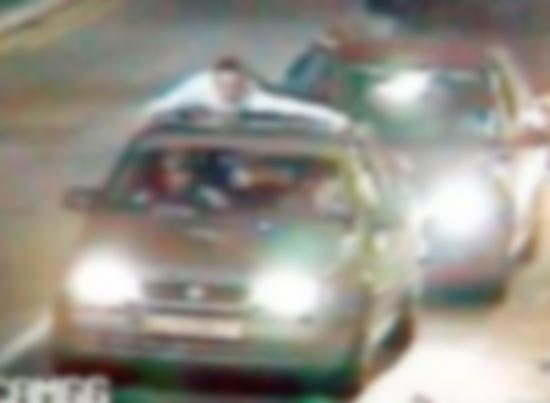 Stanza. The Rise of the Urban Surfe.
Stanza. The Rise of the Urban Surfe.
As soon as they are captured for us to observe, they become shadowy reflections of our own selves. Feral representations of strange creatures in an urban zoo. The darkness of these collected images allow us to observe our own subterranean fears, resting closely at the edge of what we as a supposedly decent society, accepts as normality. Yet there is a contradiction at play informing us that this is all too normal, part of the everyday. We are those people within these selected frames, as we scrutinize them, we judge ourselves.
One group who got their teeth stuck into the complex mess of community security and surveillance were The Office of Community Sousveillance, with the project PCSO Watch (Police Community Support Officer).
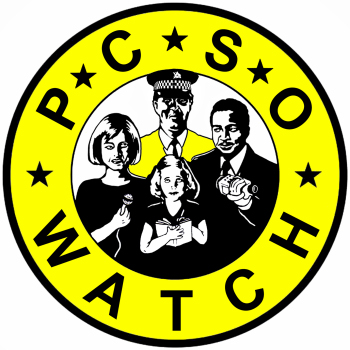
Upon entering the venue, just before stepping into the main gallery was a help desk for the visiting public to use, offering a kind of alternative community service, where visitors input information regarding their own personal experiences of being watched or hassled by local authority security. On the desk it read “PCSO Watch will be appointing its very own ‘sousveillance officers’ to co-ordinate an information gathering exercise in the period leading up to the festival. The findings of this serious-piece-of-research-completely-unmotivated-by-revenge will be made public and interactive during the festival and will be presented in collaboration with guest undercover officers operating from a mobile field unit placed temporarily in hotspots around the city.”
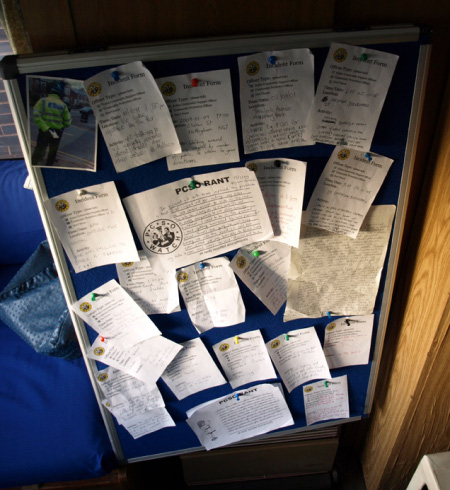
There is even a blog where you can observe or contribute to the continuing number of incidences, experiences with ‘official’ security in the Nottingham area. This art, transcends the formal realms of being objects or items of installation within an art context alone, and seeks not to be fashioned within what it sees as a limitation. It exploits the ‘imaginative’ frameworks and infrastructures of art culture itself as a creative and polemic space, considering our every day lives and relationships with the world as part of its ingredients, as an interface; allowing a certain amount of flexibility and freedom to express their own particular methodologies and political voice. It rests on the edge of what many would consider to be art and this is where its main strength lies, for it if became ‘gallery’ art, the messages and spirit of it would be lost. For it to remain in its essence vital, it needs its own agency of raw presence. This work is angry, it demands an immediacy which is direct and resolutely challenges institutional hegemony, harbouring an angst which was not uncommon with the early nineteenth century Luddites. It is art performance and direct action.
Officer B report of incident
Incident report (ref 230)
15.15-15.45 Thursday 15 January 2008
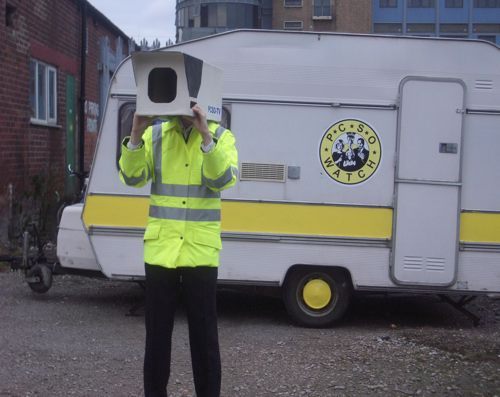 LOCATION – PCSO WATCH mobile unit parked legally (with landowners permission) on private land at the edge of Sneinton Market. Officer B was staffing the mobile unit.
LOCATION – PCSO WATCH mobile unit parked legally (with landowners permission) on private land at the edge of Sneinton Market. Officer B was staffing the mobile unit.
This work rests between legality and illegality. By posing as security officers, PCSO Watch imaginatively play at the borders of what is typically deemed right and wrong, real and unreal, pushing their expression in the form of political enactments and direct action. This is a paradigm shift that is not particularly interested in the art critic’s perspective. Their approach deliberately bypasses art dialogue and is more interested in connecting with every day people’s lives. The audience they wish to make contact with is all of us. By relocating their particular creative practice and placing it in the streets, it opens up a more cultural dynamic. Tapping immediately into the murky depths of what our society is dealing with locally, nationally and in fundamental ways – it is about reality. At the same time this work helps us to realise that outside, out there, we need more than just shops as social environments; that we need more creative and wholesome experiences in our cities coming from the ground up. Through their work, one is also aware of how vulnerable we all are to forces imposed by those who say that they care for us. Solutions to social problems need not always have to be based around monetarily orientated processes and a presumption that all civilians are potential villians, tarred with the same brush.
The energy and spirit of this work reminds me of the The Clandestine Insurgent Rebel Clown Army “…we refuse the spectacle of celebrity and we are everyone. Because without real names, faces or noses, we show that our words, dreams, and desires are more important than our biographies. Because we reject the society of surveillance that watches, controls, spies upon, records and checks our every move. Because by hiding our identity we recover the power of our acts. Because with greasepaint we give resistance a funny face and become visible once again…”
Another artwork worth highlighting is Blind Spot by Folke Kobberling & Martin Kaltwasser. I remember a day project/event that they collaborated on with Heath Bunting in Warsaw, 2008 called Fence Challenge. A one day performance of Kobberling & Kaltwasser and Bunting, an ironic play with architectural borders which get higher and steeper as a kind of obstacle run. Building fences and gates of found materials for Heath Bunting to climb over.
This time round they built small temporary structures out of building waste, with panels of wood and doors in Nottingham. These structures were designed and made to fill in spaces, blind spots where the gazes of CCTV cameras did not reach. When I saw these pieces they were exhibited in the gallery itself, but even imagining them in the streets brings a smile to one’s face.
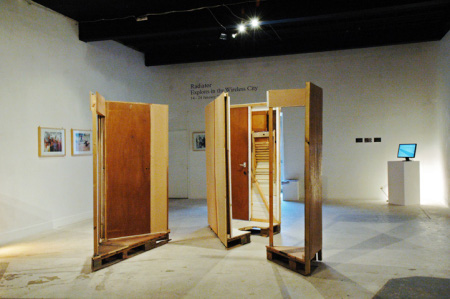
These mini- architectural builds were human scale, you could go inside and close the door behind you. Offering a haven to those who wished to avoid the perpetual gaze of cameras, to hide away for a little while when in the street, in order to reclaim some sense of privacy.
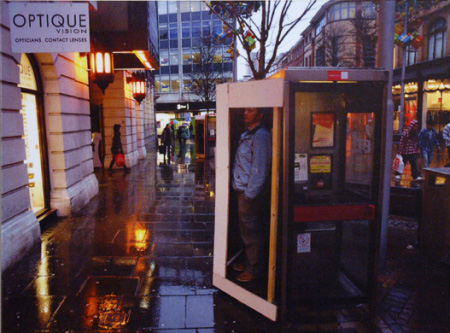
A contemporary enactment of the Orwellian vision is now here and for real, millions of lensed spectres watch our every move around the country in the streets, as the constant drone of shopping serfs waddle around in their state imposed panopticon daze. In George Orwell’s visionary novel Nineteen Eighty-Four the Thought police could view and control citizens at any moment via a tele-screen, no one knew whether they were being watched or not. Today, the UK Government is so rabid in its support of a more technocratic solutions to control its citizens, we are now the most watched soap opera by the powers that be on the planet. Us, who live in Britain are presently monitored by 4 million CCTV cameras, and if you happen to be living in London you are probably viewed on camera about 300 times a day.
A simple, search on the Internet for CCTV cameras will take you to thousands of web sites, offering you up to the minute, hi-tech CCTV equipment for the viewing of people in offices, work environments as well as the more lucrative business of selling CCTV for street surveillance. If we take a moment and consider the financial crisis, the repeating wars and climate change. It should not be a surprise to anyone that art in its various mediums and forms will naturally take account of it all and question what this means. Yet much art, whether it be performance based, activist or media art related are pushing things further in their processes, much of it challenging the very infrastructures of our institutions and their purposes for existence. This is not because they wish for a revolution, but more because they demand a better life for all, asking our institutions to become more human regarding their interaction with civilians and offer more progressive approaches. Our society needs an upgrade, pretty quick!
There were many other works at the festival worth writing about but this article would have been even longer, so I hope this will do for now. My main aim was to pull together the issues proposed by the festival commission Going Underground and discuss some of the artworks exhibited.
Regarding the Going Underground commission itself? It was successful, a much needed project and festival that desperately needed to happen. It has contributed to the larger debate on surveillance. Instead of choosing to treat art like a conveyor belt as a singular and banal process. Trampoline took a risk and moved things on further and this is to be commended. Hopefully, this endeavour will leave a legacy in Nottingham with some thought provoking challenges for all to reflect upon.
References:
[1]’A Report on the Surveillance Society For the Information Commissioner by the Surveillance Studies Network.
http://news.bbc.co.uk/1/shared/bsp/hi/pdfs/02_11_06_surveillance.pdf
[2]The Panopticon is a type of prison building designed by English philosopher and social theorist Jeremy Bentham in 1785. The concept of the design is to allow an observer to observe (-opticon) all (pan-) prisoners without the prisoners being able to tell whether they are being watched, thereby conveying what one architect has called the “sentiment of an invisible omniscience.” http://en.wikipedia.org/wiki/Panopticon
[3]Keep an eye on our growing surveillance culture
http://www.guardian.co.uk/uk/2009/feb/09/surveillance-privacy
Other links of interest:
Talking CCTV Launch.
http://www.nottinghamcdp.com/index.asp?pageid=pageid183.xml
Watching the Watchers.
Right under Big Brother’s nose, artist-hackers are using surveillance images for their own purposes.
Christopher Werth. NEWSWEEK From the magazine issue dated Sep 8, 2008.
http://www.newsweek.com/id/156339/output/print
Notes on Surveillance, Sousveillance and Inverse surveillance:
Sousveillance, originally a term French, as well as inverse surveillance are terms coined by Steve Mann – http://en.wikipedia.org/wiki/Steve_Mann (Toronto, Canada) to describe the recording of an activity from the perspective of a participant. “Surveillance” denotes the act of watching from above, whereas “sousveillance” denotes bringing the practice of observation down to human level (ordinary people doing the watching, rather than higher authorities or architectures doing the watching).
Inverse surveillance is a proper subset of sousveillance with a particular emphasis on “watchful vigilance from underneath” and a form of surveillance inquiry or legal protection involving the recording, monitoring, study, or analysis of surveillance systems, proponents of surveillance, and possibly also recordings of authority figures and their actions. Inverse surveillance is typically an activity undertaken by those who are generally the subject of surveillance, and may thus be thought of as a form of ethnography or ethnomethodology study (i.e. an analysis of the surveilled from the perspective of a participant in a society under surveillance). http://en.wikipedia.org/wiki/Sousveillance